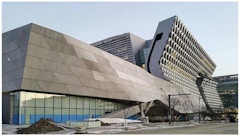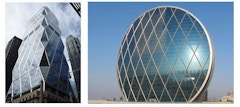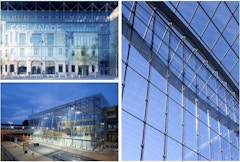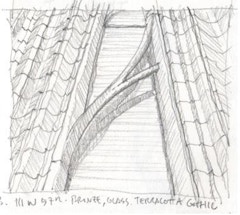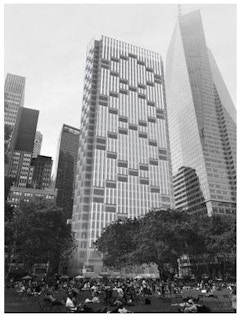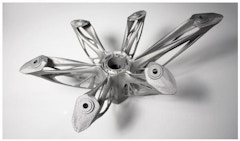
67 results
-
 Cost-effective, sustainable, self-actuating, thermally-responsive, bio-composite exo-skins that act like shields or cloaks for existing buildings…
Cost-effective, sustainable, self-actuating, thermally-responsive, bio-composite exo-skins that act like shields or cloaks for existing buildings… -

Terra Cotta Skins
- Paper by Laura B. Garofalo
This paper will address the potential of ornamental architectural terracotta surfaces to mitigate the effects of climate fluctuations that will
-

Rethinking Building Skins
- Paper by Eugenia Gasparri · Arianna Brambilla · Gabriele Lobaccaro · Francesco Goia · Annalisa Andaloro · Alberto Sangiorgio
Building skins play a pivotal role in architecture. Other than the aesthetical and architectural aspects, facades are key to the climate performance,
-

Kinetic Shading Systems
- Paper by Alireza Jahanara, Negar Kalantar,
This study focuses on experiments in kinetics and architectural skins. More extensively, it introduces a solution for environmental design issues and… -
Delivering Beauty
- Paper by Michael Mulhern,
Amidst the critical conversations about the need to build better and more efficient building skins, designers are also mindful of the need for the… -

Finally
- Paper by Michael Mulhern,
For over 60 years architects, engineers, and consultants have been specifying stainless steels for use in building skins and in some structural… -
Recent Adaptive Textile Façade Systems
- Paper by Lucio Blandini, Director, Full Professor Moon-Young Jeong, Doctoral Researcher Michael Voigt, Doctoral Researcher, IKTD, University of Stuttgart Jonathan Lopez, Doctoral Researcher Hannah Schürmann, Doctoral Researcher Arina Cazan, Research Assistant Hannah Raisch, Student Daniel Roth, Head of Research Group Methodical Product Development, IKTD, University of Stuttgart Maria Matheou, Junior Professor
Adaptive facade systems are a promising approach to achieve a dynamic response to varying weather conditions and user demands. The interdisciplinary… -
Design Considerations and the Complex Facade
- Paper by Stan Su
The design of complex, high-performance facades involves balancing attention towards principles of material selection, thermal and moisture
-

Algorithmic Patterns for Facade Design
- Paper by Inês Caetano, António Leitão,
Recently, building envelopes have been exhibiting complex shapes and patterns, a trend supported by current digital technologies. Likewise, the… -

HydroSKIN
- Paper by Christina Eisenbarth, M.Sc., Research Associate Walter Haase, Dr.-Ing., Managing Director of CRC1244, Head of Working Groups Lucio Blandini, Prof. Dr.-Ing. M.Arch., Professor and Head of the Institute Werner Sobek, Prof. Dr.-Ing. Dr.-Ing. E.h. Dr. h.c., Senior Professor
Building envelopes cover a considerable part of the urban exterior surfaces, and to therefore have a significant leverage effect on the climate… -
Fit for the Future
- Paper by Julia Koerner-Al-Rawi, Associate Adjunct Professor, Director of Summer Programs, Department of Architecture and Urban Design
Wearables protect us from climatic conditions, they provide privacy, comfort and they also reflect our style and personality. Building facades in the… -
BioFacades Classification
- Paper by Mary Ben Bonham, Kyoung Hee Kim, Professor, Director of IDRL | Founder of EcoClosure Christiane M. Herr, Professor at the School of Design, Southern University of Science and Technology, Shenzhen
Coauthors: Mary Ben Bonham, Department of Architecture + Interior Design, Miami University, Oxford, OH, USA [corresponding] [presenting at the… -
Carbon-Neutral High-Rise Envelope Nexus
- Paper by Thomas Spiegelhalter, Principal
The pathway to carbon-neutrality, as urged during the COP 21 in Paris, and the repeated goal for resilient buildings and urban habitats, winds right… -
Thinking About Facades
- Paper by Marc Schiler, FASES, LC
There have been three decades of liberating developments in the application of descriptive geometry and freeform design methods, as well as the
-
Adaptive Facades
- Paper by Walter Haase · Werner Sobek · Enrica Oliva · Michele Andaloro
Facade engineering aims at appropriately balancing the demands imposed by the context and the capabilities inherent to the materials, the geometries
-
Structural Skin
- Paper by John Neary
Many prominent, recent buildings feature forms suggesting structural surface while their enclosures are really non-load-bearing curtain wall. At the
-
Shaping Skin
- Paper by John Neary AIA LEED AP NCARB
The conventional modern facade is essentially flat, which creates the tendency toward visual monotony and problems for modulating daylight—both on
-
Structuring Skin
- Paper by John Neary
Curtain wall is the prevailing type of enclosure on modern buildings because of its economy, its independence from structure that allows flexibility
-
The Double Skin Facade
- Paper by Lee A. Fithian, AIA, AICP, NCARB, LEED AP
The largest source of air pollution in North America is the atmospheric boundary layer of a city caused by its urban canyons with pollutants produced
-
Differentiated Building Skin
- Paper by James Warton
The Los Angeles Stadium’s doubly curved skin is composed of over 35,000 unique triangular panels covering 296,502 square feet of surface area. The
